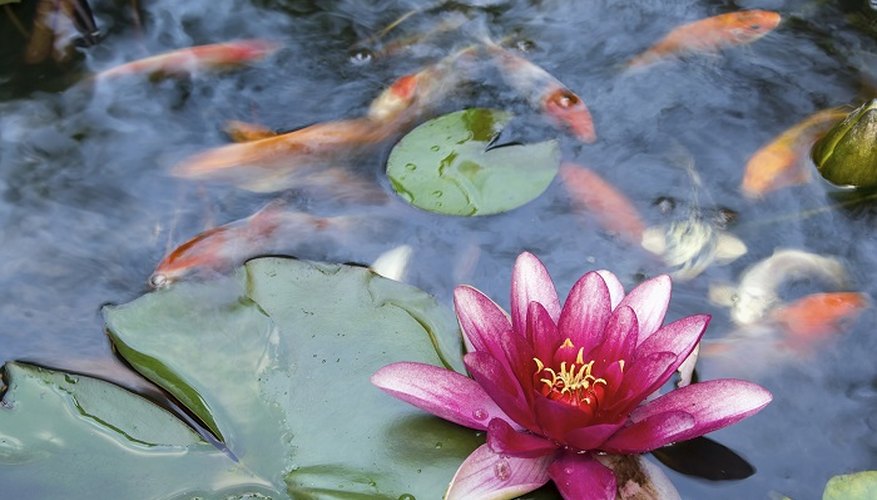Koi and goldfish are fairly tough pond fish and will tolerate less-than-ideal conditions for a time. But the fish will remain healthiest and live longest in relatively clear, clean water, so it is important to identify possible causes of cloudy and colour-tinted water immediately to maintain a liveable pond. Green water occurs when there is an overbloom of algae. Grey-coloured water and cloudiness are signs that something else is off-balance.
Poor filtration
Fish ponds need good filtration and cloudy, grey water may indicate the filters are inadequate or not working. Adding an adjacent biofilter pond may help to keep the water clear. A biofilter pumps water through the extra, shallow pond where beneficial bacteria -- that cling to an inorganic filtration media like plastic beads or gravel -- remove ammonia and nitrites from waste. The cleaned water is then returned to the main pond in constant recirculation. Regular bottom cleaning to remove sludge build-up will help the filters do their job.
- Fish ponds need good filtration and cloudy, grey water may indicate the filters are inadequate or not working.
- Regular bottom cleaning to remove sludge build-up will help the filters do their job.
Silt and lack of oxygen
Ponds need critical amounts of oxygen and a number of conditions can contribute to oxygen depletion, which is highly stressful to fish. Run-off due to heavy rains may contain silt and sediment that clouds the pond as well as rubbish and pesticides that can choke oxygen-producing plants and turn the water toxic and murky. Protect the pond from run-off with built-up walls and don't use pesticides on lawns and gardens adjacent to the pond. Use a binding material like gypsum or calcium carbonate to remove suspended clay particles from the water. Add more pond plants to help restore clear water and oxygen balance. Install a waterfall for extra aeration.
- Ponds need critical amounts of oxygen and a number of conditions can contribute to oxygen depletion, which is highly stressful to fish.
- Use a binding material like gypsum or calcium carbonate to remove suspended clay particles from the water.
Over-feeding
Fish produce waste that can cloud the water in their pond, especially when the pond supports a large number of goldfish or large koi. Monitor feeding to avoid the overfeeding that creates excess waste and leaves decomposing food in the water. Feed once or twice a day or even every two days, depending on the fish, the size of the pond and the plants available for the fish to nibble. Feed the fish by tossing food to them for about five minutes. As soon as they stop feeding, stop tossing. The fish and the pond will be healthier.
- Fish produce waste that can cloud the water in their pond, especially when the pond supports a large number of goldfish or large koi.
Overcrowding
Fish grow rapidly and can multiply quickly. Your two or three ornamental koi may shoot up from 10 cm long to 50 cm and produce enough offspring in a few years to overpopulate their pond. Develop a plan to cull extra fish from the pond, by giving them to friends or distributing fish through a local pet store. You will need to work out a safe, quarantine system to ensure the health of the fish you give away. But keeping all of them guarantees that your pond will be overpopulated, the water will not remain clear and the fish will all be endangered due to poor pond conditions and stressed immune systems. Culling the new fish before they grow up is another simple way to keep the population down. Keep the darker goldfish and the most robust koi at about 1 month old.
- Fish grow rapidly and can multiply quickly.
- Your two or three ornamental koi may shoot up from 10 cm long to 50 cm and produce enough offspring in a few years to overpopulate their pond.
